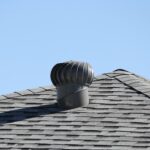Residential roof ventilation is based on the simple fact that warm air rises. In summer, the sun heats the air in the attic. In winter, heat from your home warms the attic air. In either season, good venting occurs when cool air can enter the attic near the eaves and exit near the peak.
10 Reasons Why Roof Ventilation is Important
The following are 10 reasons why residential roof ventilation is important:
- Moisture Control: Proper ventilation helps prevent the buildup of excess moisture in your attic or roof space. This prevents issues like mold growth, rotting wood, and deterioration of insulation.
- Temperature Regulation: Ventilation helps regulate the temperature in your attic, preventing it from becoming excessively hot during the summer and too cold during the winter. This can lead to energy savings by reducing the strain on your HVAC system.
- Prevents Ice Dams: In colder climates, proper ventilation can prevent the formation of ice dams on your roof. Ice dams form when warm air from the attic melts snow on the roof, which then refreezes at the eaves. Proper ventilation helps keep the roof temperature consistent, preventing this cycle.
- Prolong Roof Life: Excessive heat in the attic can lead to premature aging of roofing materials. Ventilation helps extend the lifespan of your roof by reducing the risk of shingle distortion, warping, and other forms of damage.
- Energy Efficiency: A well-ventilated attic can reduce the load on your air conditioning system by preventing the accumulation of hot air. This can result in lower energy bills, as your cooling system won’t have to work as hard to maintain a comfortable indoor temperature.
- Prevents Condensation: Adequate ventilation helps prevent condensation from forming in the attic. Condensation can lead to the deterioration of insulation, wood, and other materials, potentially causing structural issues over time.
- Preserves Insulation Effectiveness: Improperly vented attics can cause the insulation to become less effective due to moisture accumulation. This can lead to higher heating and cooling costs, as well as reduced comfort indoors.
- Air Quality: Proper ventilation helps maintain better indoor air quality by preventing the accumulation of pollutants, allergens, and other airborne particles in the attic space.
- Prevents Attic Heat Transfer: Without proper ventilation, heat can transfer from the attic to the living spaces below, causing discomfort and increasing energy consumption to cool those spaces.
- Code Compliance: Many building codes require proper roof ventilation for safety and energy efficiency reasons. Having adequate ventilation ensures your home meets these requirements and may even be necessary for warranty coverage on roofing materials.
Roof Ventilation Types of Vents
The most common types of roof vents include ridge vents, turbine vents, power vents, soffit vents, gable vents, roof louvers, and roof jacks.
 Ridge vents: Ridge vents are the most common type of exhaust vent. They are installed along the roof’s peak and allow hot air to escape from the attic. Ridge vents are effective because they provide a continuous venting area along the entire length of the roof.
Ridge vents: Ridge vents are the most common type of exhaust vent. They are installed along the roof’s peak and allow hot air to escape from the attic. Ridge vents are effective because they provide a continuous venting area along the entire length of the roof.

Turbine vents: Turbine vents use wind to rotate a turbine, which in turn, pulls hot air out of the attic. They are effective in areas with high winds.

Power vents: Power vents use electricity to move hot air out of the attic. They are effective in areas with high humidity.

Soffit vents: Soffit vents are installed under the eaves of the roof and allow cool air to enter the attic. They work in conjunction with other types of exhaust vents, such as ridge or turbine vents.

Gable vents: Gable vents are installed on the gable ends of an attic and allow hot air to escape from the attic. They work best when used in conjunction with soffit or ridge vents.

Roof louvers: Roof louvers are similar to gable vents but are installed on the roof itself. They work best when used in conjunction with other types of exhaust vents.

Roof jacks: Roof jacks are used to vent pipes that penetrate through the roof. They can be used in conjunction with other types of exhaust vents.
For intake air, soffit vents are best. Air can passively exit through ridge vents or hood vents. Turbine vents harness the wind to suck air out of the attic. Electric-powered vents are the ultimate air movers but aren’t necessary in most situations. Gable vents can help by allowing air in or out, but they don’t usually help the airflow evenly throughout the attic.
Choosing the Right Type of Roof Vent
When determining the best roof vent for your home, you’ll find many types are available. They come in two main models: intake and exhaust, both of which are required to properly ventilate a roof.
Intake vents allow cool air to enter the attic and help push out the hot air, which freshens the space and decreases air temperature. You can place intake vents on the roof in one or more different areas.
Soffit vents are holes in the panel under the house’s eaves that allow fresh air to enter the attic space.
In older homes, these vents are similar in appearance to the heating and air conditioning registers inside the house. These vents are spaced around the home on the soffits to provide adequate ventilation.
Newer homes typically have long, perforated vinyl soffits that allow for maximum ventilation. Many homeowners prefer soffit vents because they don’t detract from the appearance of the house.
Drip edge vents are suitable for homes that lack the roof overhang required for a soffit vent.
When choosing a roof vent, you should consider factors such as your climate, your home’s architectural style, and your local climate.
Calculating the Number of Vents Needed
The number of roof vents you need depends on the size of your attic and the type of vent you choose.
A general rule of thumb is to have at least 1 square foot of ventilation for every 150 square feet of attic space.
For example, if your attic is 900 square feet, you would need a total of 6 square feet of ventilation. If you are using ridge vents, you should have a continuous vent along the entire ridge. If you are using gable vents, you should have one vent on each end of the attic. If you are using soffit vents, you should have them installed along the entire length of the eaves.
Deciding if Your Attic Has Enough Ventilation
The amount of ventilation required for an attic depends on the size of the attic and the type of vent used. If you are unsure whether your attic has enough ventilation, you can check for the following signs:
- High energy bills: If your attic is not properly ventilated, it can trap hot air in the summer and cold air in the winter. This can cause your HVAC system to work harder, which can lead to higher energy bills.
- Ice dams: Ice dams form when warm air from the attic melts snow on the roof. The water then refreezes at the edge of the roof, creating a dam. This can cause water to back up under the shingles and into your home.
- Mold and mildew: Poor ventilation can cause moisture to build up in your attic, which can lead to mold and mildew growth.
- Roof damage: Excessive heat buildup in your attic can cause shingles to deteriorate faster than they should, which can lead to roof leaks and other damage. If you notice any of these signs, it may be time to add more ventilation to your attic.
In conclusion, your residential roof ventilation plays a vital role in maintaining the health and efficiency of your home. Residential roof ventilation is a critical component of maintaining a healthy, energy-efficient, and structurally sound home. It helps prevent issues related to moisture, temperature extremes, and deterioration while contributing to a comfortable living environment and long-term cost savings.
Tip: Soffit vents are the intake, and roof vents are the exhaust; just like your car, one without the other will not work.

Contact Us today!
![]()
